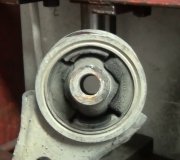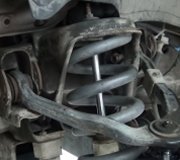Changing to the "long arm/short arm, (SLA) suspension system is not practical. The frame rails do not have the attachment points for the bushings, and the frame is not shaped correctly to even make that modification possible. There is also no where to place the coil springs so they will push down on the lower control arms. If this is a really big deal to you, look at this as an opportunity to go out and buy exactly the vehicle you want.
There are also legal ramifications to doing these kinds of modifications. The biggest issue to me as a suspension and alignment specialist and as a brake system specialist is the difference in weight and the difference in weight transfer during hard stopping between the two systems. The dual brake hydraulic system is very carefully designed so the front and rear are balanced and will provide maximum stopping power.
A skidding tire has no traction, so when that happens during hard breaking, you have to let up on the brake pedal to get that wheel turning again. That means you had three brakes not yet stopping to their full potential, but you let up on the brakes. A good lawyer or insurance investigator will convince a jury that you were partly at fault for the crash caused by their client who ran the red light because you were less able to avoid it, and they will be right. This is also why alignment specialists get real excited and often refuse to get involved with lowered cars and raised trucks. We become party to any future lawsuit even if what we repaired has nothing to do with those modifications.
Stick with the system you have, but there are things to improve on it. The SLA system offers the best ride quality because with every bump a tire hits, that road shock has to change direction multiple times as it passes through the geometric angles formed by the suspension system's parts, before it finally reaches the steering wheel. The drawback is the system is heavy and takes up too much room to be practical on small front-wheel-drive cars.
McPherson strut and modified strut suspension is very compact, lightweight, and inexpensive, but ride quality is a compromise. It's not as strong in a crash too.
Your I-beam suspension system has the worst ride quality of any suspension system, but the trade-off is it is the strongest system. Other than a bent wheel, it is the least likely system to sustain damage if you slide into a curb. This is the only system used on larger, heavy trucks. It's kind of over-kill for a van, but it gets the job done.
The worst system by far is the twin I-beam suspension found on the downsized Bronco 2 and Ranger pickup trucks. The I-beam part gives it its strength, and the twin part improves somewhat on ride quality over the single I-beam. The huge problem with this system is easy to see when the truck is lifted on a hoist. The tires tip way out on top. They're actually tipping in and out as the truck bounces up and down on the highway, and that leads to terrible tire wear. Ride height is also critical to reduce tire wear, so we replace the coil springs very often. The engineers couldn't be bothered to put a simple alignment adjustment on these trucks, so you keep on replacing springs or tires, or both.
Getting back to improving your system, the vans and the two-wheel-drive pickups had a known problem of accelerated right front tire wear. The dealer's answer was you were supposed to be rotating them often, but that just meant all four would wear out very quickly. The characteristic was that tire would wear rapidly on the outer edge and it would develop a cupped wear pattern. The modification to reduce that wear is to replace the right front shock absorber with a heavy-duty one, and to replace the strut rod bushing with one of a harder rubber compound. To maintain even braking and handling, both shock absorbers and both bushings should be replaced. Replacing the parts on the left side doesn't improve or reduce right front tire wear. Those are just replaced so the parts are the same on both sides. Ride quality is not reduced but the new parts on the right side cut the right front tire's wear in half.
For the steering response, first be aware you've been driving cars with very responsive rack and pinion steering gears for a long time, and that is what we get used to. You aren't going to get the same feel from a '70s truck. That said, this is a good time to inspect the steering components. Ford has had much more trouble with their steering system parts than all other manufacturers combined, but they have had very little trouble with their steering gear boxes. Start by looking at the tie rod ends. Some of their designs make it very difficult to see objectionable wear and movement when tugging on them by hand the way we normally do. Instead, run the engine, then watch the tie rod ends and bushings while a helper rotates the steering wheel back and forth a little. This should only be about 1/8th turn left and right at the most. That is plenty to see movement between the balls and sockets. More than that, and it's hard to see that movement when the entire steering linkage is moving around.
Your truck doesn't use an idler arm. When you do have one, watch to see if it moves up and down when your helper is moving the steering wheel. When you see that, you'll see the right front wheel is moving left and right in relation to the left front wheel. That causes a lot of tire wear and steering wander.
While this is not a good suspect on your truck, watch where the pitman shaft comes out of the bottom of the steering gear box. You might see it turning back and forth a little, but if you look very closely, you do not want to see it moving left and right within the housing. When that kind of wear occurs, as you turn the steering wheel, that shaft moves sideways, bottoms out, then it starts to turn and move the wheels. Typically, if you have to guess if the play is too much, it isn't. This occurs more often on newer vehicles because the bearing that shaft rides on has been replaced by a bushing that gets hammered out over time. The more it wears, the faster that wear continues to occur. Once bad enough, the shaft can move far enough to one side that it pulls away from the rubber seal, and you have a power steering fluid leak. Check for wetness around that shaft which would suggests fluid has been leaking out.
Also look for worn king pins. That will cause excessive steering wander. The harder one to identify is a tight king pin. That will cause "memory steer". That is where you place the steering wheel someplace, and it stays there until you tug the wheel back to center. When jacked up, you won't be able to turn the wheels left and right by hand. If a tight king pin becomes really bad, you'll have to struggle with both hands to turn the steering wheel, and you will hear a loud banging sound each time it snaps and turns a little. Before it gets that bad, it can mistakenly be identified as steering wander. That's because you have to constantly keep on correcting the steering. The wheels are not free to track straight down the road on their own.
When your helper is turning the steering wheel for you, watch if the wheels respond right away. If there is a delay, look at the couplers in the input shaft coming down from the steering wheel. There is one that looks like a 3" or 4"-diameter piece of a tire carcass, and has four bolts attached to it. Those rarely cause a problem, but be sure the bolts are in there. Often there is also a small universal joint. On little cars those are under the dash. On trucks, when used, they'll be under the hood. Those bearings can become tight or they can become sloppy. When they're tight, you'll commonly feel a binding sensation twice per steering wheel revolution, and the wheel won't come back to center on its own. When they're sloppy, you'll feel the banging in the steering wheel, and you might hear a metallic clunking sound.
Saturday, December 15th, 2018 AT 7:48 PM


